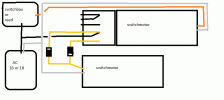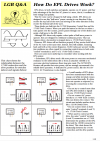Hi all,
I'm a total newbie here and have been wiring up an automated alternating station circuit with signals (a combination of Circuit 5 and the Circuit Blocks on the World of LGB document). I need to at least move one of the switches/points to ensure the trains alternate/return to their spot in the station before sending the other one off. Is my only option to use more of the reed switches to send a signal to the point/switch to move or can I use all these open spaces on the DPDT switch to move things around? I have the reed switches so maybe that's easiest but through I'd ask in case there is another clever option.
In addition, I'm using an old 5003 power supply just for AC power to the EPL system. (On advice of this forum I did find a 5A throttle that I'm using combined with a Mean Well power supply.) It says it's 16VAC. In a number of threads on here it seems that 18VAC is recommended and possibly even using the booster box, 52750. I am seeing some sluggish movement on the signals I purchased used. Do those two extra volts really make a difference in more reliable movement? My understanding is still in it's infancy but I get the sense that buying an 18VAC power supply/transformer off Amazon would not plug and play, correct? I would need either an LGB part or to use some electronics to modify the AC power?
Thanks!
Vince
I'm a total newbie here and have been wiring up an automated alternating station circuit with signals (a combination of Circuit 5 and the Circuit Blocks on the World of LGB document). I need to at least move one of the switches/points to ensure the trains alternate/return to their spot in the station before sending the other one off. Is my only option to use more of the reed switches to send a signal to the point/switch to move or can I use all these open spaces on the DPDT switch to move things around? I have the reed switches so maybe that's easiest but through I'd ask in case there is another clever option.
In addition, I'm using an old 5003 power supply just for AC power to the EPL system. (On advice of this forum I did find a 5A throttle that I'm using combined with a Mean Well power supply.) It says it's 16VAC. In a number of threads on here it seems that 18VAC is recommended and possibly even using the booster box, 52750. I am seeing some sluggish movement on the signals I purchased used. Do those two extra volts really make a difference in more reliable movement? My understanding is still in it's infancy but I get the sense that buying an 18VAC power supply/transformer off Amazon would not plug and play, correct? I would need either an LGB part or to use some electronics to modify the AC power?
Thanks!
Vince



